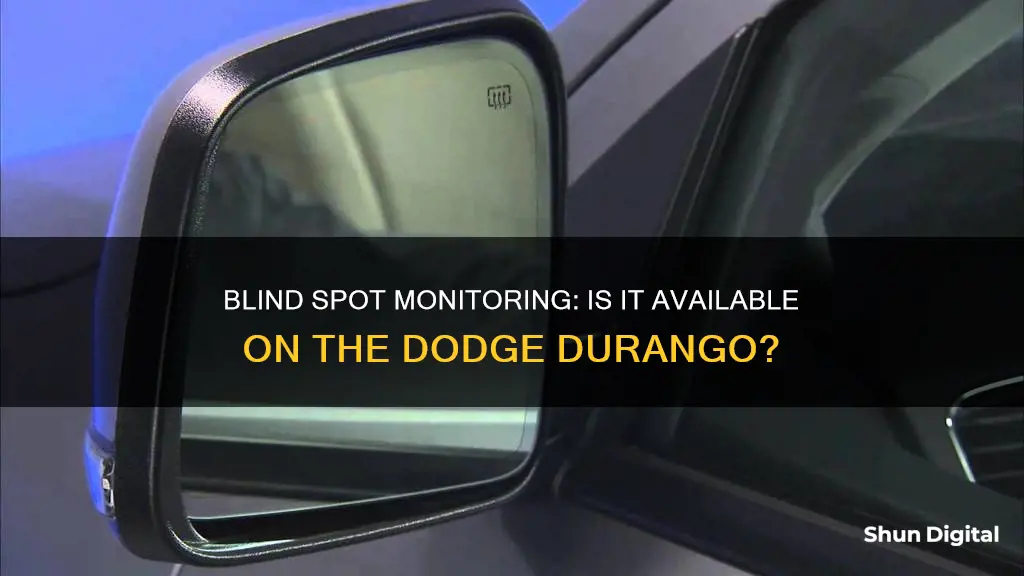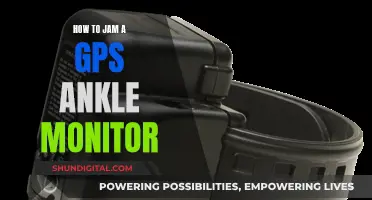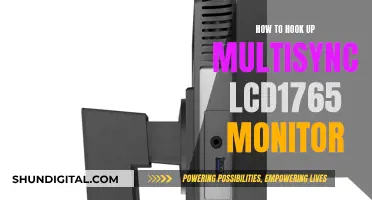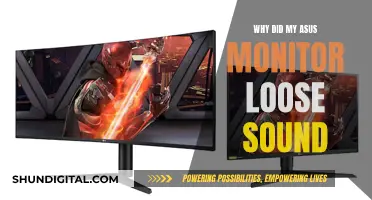
The Dodge Durango is a large vehicle with several safety features. One of the most important features is blind-spot monitoring, which uses radar-based sensors located inside the rear bumper to detect other vehicles that enter the blind spot zones from the rear, front, or side of the car. The system alerts the driver through integrated visual and audible warnings when another vehicle enters their blind spot. The Durango also has advanced braking technology, lane departure warning, and forward-collision warning to ensure a safe driving experience.
| Characteristics | Values |
|---|---|
| Blind Spot Monitoring | Available as an add-on feature |
| How it works | Uses two radar-based sensors located inside the rear bumper fascia to detect vehicles that enter the blind spot zones from the rear/front/side of the vehicle |
| When it works | When the vehicle is in any forward gear or reverse; enters standby mode when the vehicle is in park |
| Detection zone | Covers approximately one lane on both sides of the vehicle, 12 ft (3.8 m) in length and 10 ft (3 m) beyond the rear bumper |
| Alerts | Illuminates the BSM warning light in the outside mirrors, sounds an audible alert, and reduces the radio volume |
| What it doesn't alert for | Rapidly approaching vehicles outside the detection zones, stationary objects, objects traveling in the opposite direction, pedestrians, bicyclists, or animals |
What You'll Learn
- The Blind Spot Monitoring (BSM) system uses two radar-based sensors to detect vehicles entering blind spots
- BSM does not alert drivers about rapidly approaching vehicles outside detection zones
- BSM sensors are located inside the rear bumper fascia and operate when the vehicle is in any forward gear or reverse
- BSM systems are designed not to issue alerts for stationary objects, but occasionally they may
- BSM does not detect pedestrians, bicyclists, or animals, so drivers must remain vigilant

The Blind Spot Monitoring (BSM) system uses two radar-based sensors to detect vehicles entering blind spots
The Dodge Durango is equipped with Blind Spot Monitoring (BSM) technology, which uses two radar-based sensors to detect vehicles entering blind spots. This system is designed to aid drivers in detecting objects in their blind spot zones, enhancing overall safety.
The BSM sensors are strategically located inside the rear bumper fascia, enabling them to monitor vehicles entering the blind spot zones from the rear, front, or sides of the Durango. The detection zone covers approximately one lane on both sides of the vehicle, extending 12 feet (3.8 meters) from the outside rearview mirror to 10 feet (3 meters) beyond the rear bumper. The system becomes operational when the vehicle is started, indicated by a momentarily illuminated BSM warning light in both outside rearview mirrors.
The BSM system is designed to alert the driver of vehicles within the detection zones by illuminating the BSM warning light in the outside mirrors, sounding an audible chime, and reducing the radio volume. It is important to note that the BSM system does not alert the driver about rapidly approaching vehicles outside these zones. Additionally, the detection zone remains unchanged when towing a trailer, requiring drivers to visually verify the adjacent lane's clearance before changing lanes.
To ensure the proper functioning of the BSM system, it is crucial to keep the area where the radar sensors are located free from obstructions such as snow, ice, dirt, or road contamination. Similarly, foreign objects like bumper stickers or bicycle racks should not be placed over the sensors. By maintaining a clear and unobstructed sensor area, drivers can maximise the effectiveness of the BSM system and enhance their overall safety while driving the Dodge Durango.
Diffusion Tubes: Where to Buy for Pollution Monitoring
You may want to see also

BSM does not alert drivers about rapidly approaching vehicles outside detection zones
The Dodge Durango is equipped with a Blind Spot Monitoring (BSM) system that uses two radar-based sensors located inside the rear bumper fascia to detect vehicles that enter the blind spot zones from the rear, front, or side of the vehicle. This system sends alerts to the driver through integrated visual and audible warnings when another vehicle enters their blind spot or when an obstacle is in the way while backing out of spots.
While the BSM system in the Dodge Durango offers valuable assistance to drivers, it is important to recognize its limitations. One such limitation is that the BSM system does not alert the driver about rapidly approaching vehicles that are outside the detection zones. This means that if a vehicle is approaching at a high speed from an adjacent lane and has not yet entered the blind spot zone, the driver will not receive a warning.
The BSM detection zone covers approximately one lane on both sides of the vehicle, extending 12 feet (3.8 meters) from the outside rearview mirror to 10 feet (3 meters) beyond the rear bumper. When a vehicle enters this detection zone, the BSM system will notify the driver through visual and audible alerts. However, if a vehicle is approaching too quickly from outside this zone, the driver will not be alerted.
It is crucial for drivers to understand the limitations of the BSM system and not solely rely on it for their safety. Even with the BSM system, drivers should always visually check their mirrors, glance over their shoulder, and use their turn signals before changing lanes. By adopting safe driving practices and utilizing the BSM system as an additional tool, drivers can enhance their overall safety on the road.
To summarize, while the Dodge Durango's BSM system provides valuable assistance in detecting vehicles in the blind spot zones, it does not alert drivers about rapidly approaching vehicles outside the detection zones. Therefore, drivers should remain vigilant and actively monitor their surroundings to ensure a safe driving experience.
Simple Ways to Check Your Monitor's Refresh Rate
You may want to see also

BSM sensors are located inside the rear bumper fascia and operate when the vehicle is in any forward gear or reverse
The Dodge Durango is equipped with a Blind Spot Monitoring (BSM) system that uses two radar-based sensors located inside the rear bumper fascia. These sensors detect vehicles that enter the blind spot zones from the rear, front, or side of the Durango. The BSM system operates when the vehicle is in any forward gear or reverse and enters standby mode when the vehicle is in park.
The BSM detection zone covers approximately one lane on both sides of the Durango, starting from the outside rearview mirror and extending about 10 feet (3 meters) beyond the rear bumper. The system monitors these detection zones on both sides when the vehicle speed reaches approximately 6 mph (10 km/h) or higher. It alerts the driver of vehicles in these areas through integrated visual and audible warnings. The BSM warning light is located in the outside rearview mirrors, and the system also reduces the radio volume to ensure the driver notices the alert.
It is important to note that the BSM system does not alert the driver about rapidly approaching vehicles outside the detection zones. Additionally, the detection zone remains unchanged when towing a trailer, so drivers must visually verify the adjacent lane is clear before changing lanes. The sensors must be kept free of snow, ice, and dirt to function properly, and the area should not be blocked by foreign objects such as bumper stickers or bicycle racks.
The Blind Spot Monitoring system in the Dodge Durango is a valuable safety feature, but it is essential to remember that it is only an aid. Even with the BSM system, drivers should always check their mirrors, glance over their shoulders, and use their turn signals before changing lanes to avoid potential serious injury or death.
Understanding Monitor Sizes: A Guide for Canadians
You may want to see also

BSM systems are designed not to issue alerts for stationary objects, but occasionally they may
The Dodge Durango is equipped with a Blind Spot Monitoring (BSM) system that uses two radar-based sensors located inside the rear bumper fascia to detect vehicles that enter the blind spot zones from the rear, front, or side of the vehicle. The BSM system is designed to send alerts to the driver through integrated visual and audible warnings when a vehicle enters the blind spot zones.
While the BSM system is designed not to issue alerts for stationary objects, it may occasionally do so. This is because the BSM system uses radar-based sensors to detect objects in the blind spot zones, and these sensors may sometimes detect stationary objects as potential hazards. This is normal operation, and the vehicle does not require service.
The BSM system in the Dodge Durango operates when the vehicle is in any forward gear or reverse and enters standby mode when the vehicle is parked. The detection zone covers approximately one lane on both sides of the vehicle, starting from the outside rearview mirror and extending beyond the rear bumper. The system monitors the detection zones on both sides when the vehicle speed reaches approximately 6 mph (10 km/h) or higher and will alert the driver of vehicles in these areas.
It is important to note that the BSM system in the Dodge Durango is not perfect and may have some limitations. For example, it may not alert the driver about rapidly approaching vehicles outside the detection zones or when towing a trailer. Additionally, the BSM system is not designed to detect pedestrians, bicyclists, or animals, so it is important for drivers to remain vigilant and check their mirrors and surroundings before changing lanes.
Overall, the BSM system in the Dodge Durango is a valuable safety feature that can help prevent accidents and improve the driving experience. However, it is essential to understand its limitations and not rely solely on this system for blind spot detection.
Ankle Monitor Recovery: Rewards and Return
You may want to see also

BSM does not detect pedestrians, bicyclists, or animals, so drivers must remain vigilant
The 2023 Dodge Durango is equipped with Blind Spot Monitoring (BSM) and Rear Cross Path Detection, which help to notify the driver when another vehicle enters their blind spot or when an object is in the way while reversing. The BSM system uses two radar-based sensors located inside the rear bumper fascia to detect licensable vehicles (automobiles, trucks, motorcycles, etc.) that enter the blind spot zones from the rear, front, or side of the vehicle.
While the BSM system in the Dodge Durango offers valuable assistance to drivers, it is important to remember that it has certain limitations. Specifically, the BSM does not detect pedestrians, bicyclists, or animals. This is a significant limitation that drivers should be aware of and plan for. As a driver, it is your responsibility to remain vigilant and actively look for pedestrians, bicyclists, and animals, in addition to other vehicles.
Pedestrians and bicyclists are vulnerable road users who often face a higher risk of injury or fatality in traffic collisions. They may be less visible than cars due to their smaller size, lack of lights, or not wearing bright or reflective clothing, especially at night or in poor weather conditions. They can also be unpredictable in their speed and movement, entering roads from unexpected locations, such as between parked cars or from behind buses or other vehicles.
To ensure the safety of all road users, drivers must take special care to be aware of their surroundings and drive as safely as possible. This includes actively looking for pedestrians, bicyclists, and animals, not just relying on the BSM system. Before changing lanes or making a turn, it is crucial to check your mirrors, glance over your shoulder, and use your turn signal. By combining the use of BSM with your own visual checks, you can maximize your awareness of potential hazards and help prevent accidents.
In addition to visual checks, there are other measures drivers can take to increase their awareness of pedestrians, bicyclists, and animals. For example, when approaching a pedestrian or cyclist from behind, slow down and give them extra space. Be cautious when backing up or reversing, as these road users may be in your blind spot. It is also important to obey traffic rules and signals, stay alert, and avoid distractions that take your focus off the road. By adopting defensive driving practices and remaining vigilant, you can help keep yourself and other vulnerable road users safe.
Monitoring Energy Usage: Circuit Box Insights
You may want to see also
Frequently asked questions
Yes, the Dodge Durango is equipped with a Blind Spot Monitoring (BSM) system that uses two radar-based sensors located inside the rear bumper fascia to detect vehicles that enter the blind spot zones from the rear, front, or side of the vehicle.
When the vehicle is started, the BSM warning light illuminates momentarily in both outside rearview mirrors to notify the driver that the system is operational. The BSM system sensors are active when the vehicle is in any forward gear or reverse and enter standby mode when the vehicle is parked. The BSM detection zone covers approximately one lane on both sides of the vehicle, starting from the outside rearview mirror and extending about 10 feet beyond the rear bumper.
It may be possible to add blind spot monitoring to your Dodge Durango if it didn't come with it originally. However, it could be difficult and expensive. You may need to install new radar sensors, mirrors, and a rear wiring harness, as well as reprogram the computer. It's recommended to consult a professional or refer to the Dodge Durango Owner's Manual for more information.







